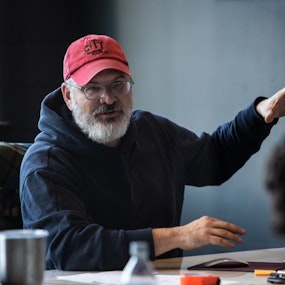The City Museum’s Authentic Design Philosophy

The https://www.citymuseum.org/ in St Louis hosts haunters for a yearly party during https://haashow.com/. The massive space is about interactive play, where the local team makes everything from recycled materials. The Museum was hit hard by the...
The City Museum in St Louis hosts haunters for a yearly party during Transworld’s Halloween & Attractions Show. The massive space is about interactive play, where the local team makes everything from recycled materials. The Museum was hit hard by the pandemic, but now that they’ve recovered, what’s the plan? We speak with Rick Erwin, Creative Director of the City Museum, to learn about their design philosophy. Support for this episode comes from Gantom Lighting and Controls. See what you’re missing with a free demo. Subscribe to everything from the Haunted Attraction Network here.
Rick Erwin: My name is Rick Erwin, I'm the creative director of City Museum in St. Louis, MO. City Museum is like this mirror ball, we all see it differently, but it's an interactive play space from recycled materials. What draws people to City Museum is one is everything is built and designed by us, it's all in-house, so it's all our team, and then it's built from materials that are leftover, recycled materials. I mean, we got two airplanes outside, I got a bus on the roof, Ferris Wheel on the roof, still 80% to 90% recycled materials. There's nothing here that's fancy, I mean it's all get in and gravity pulls you, or something like that. I think that's kind of what brings people together, and everybody can do it, both kids and adults.
Philip Hernandez: Give us a sense of the scale.
Rick Erwin: The building the City Museum is in is 625,000 square feet. City Museum occupies floors 1 through 4, and then we occupy the 10th floor and then the roof. So, floor one is part a parking garage where we do all our work, we have stone shops and a weld shop. Then we have the front half, which was originally called Aquarium, it's a mix of aquarium and museum. Then on the 2nd floor, we actually have an aquarium. We have a rental space, but then as you move up to our third floor, we have Skateless Park, we have BeatnikBobs, we have Toddler Town, we have Architectural Museum, we have a three-story slide, but it also gives you access to this space we're in here, which is known as the. Caves.
So, above us, there are 2 ten-story spiral slides, and a five-story spiral slide, there's miles of tunnels around us. So, right now we have people above us and below us behind us. It was the idea that Bob likes music, the fact that music could involve you and get inside you, and that's what we try to do with our sculptures and stuff. As we move out from here, we go to the 4th floor. 4th floor has our architecture, Louis Sullivan, we have a contemporary art gallery. Then as you go up to the roof, that's where we have a 1950 Eli Bridge Ferris Wheel, we have three-story slides, we have two climbers, a bus you can get in, a park, it's just it's a little bit of everything. There is a city within a city, that way we can maintain ourselves.
Philip Hernandez: Tell us a little bit about where we're standing in right now.
Rick Erwin: So, what we're in right now is this is the Enchanted Caves. This is probably one of the top three attractions at City Museum that people want to be in. So, it's exactly like a general cave system. It's all sprayed gunite. The creatures and stuff that you see, it's like when you were a kid and you're trying to go to sleep and you look at the ceiling, you see things, same thing. Spray it, shave it, and move on. So, it's a lot of recycled materials. There are spots in there that are made by Christmas ornaments that have been sprayed over, there's chicken wire, and it's just a labyrinth of tunnels.
Philip Hernandez: Tell me a little bit about what your plans are for expanding City Museum, what are you guys trying to do overall?
Rick Erwin: We've got floors one through three filled. Four, we still, we're running half of it so we could cut across. We have some secret mazes and stuff we're working on over there. I'm sure there'll be plenty of Gantom in there. Then we'll move to the roof. We only use about 20,000 square feet of a 65,000 square-foot roof That's 10 stories up. The Ferris is 13 stories up. So, we have a whole skyline that we still plan to change.
Philip Hernandez: Do you have a North star or a design philosophy that you think about when you're looking at expansions? Because you said a lot of things like, city within a city, and just the idea of families being able to play together and interact and that realism to it. But what's your guiding star?
Rick Erwin: Authenticity. Everything has to be authentic. If I can buy it, I don't want it. I want to be able to create it. We want to take the challenge on to see if we can do it. On the third floor, there are train wheels set up on their sides to make a spiral staircase. We just wanted to see if we could do it. We had to put a slide on it to make it worth something. For us, it's all about just trying and seeing what we can push.
Philip Hernandez: What do you think the biggest challenge is going to be for you all going forward?
Rick Erwin: The biggest challenge for us right now is, still, getting skilled workers, like creative people that we can get. This is my call out right now. We've lost some of our crew because they've had to go on, and doing amazing things actually, building slides and stuff everywhere, we support them. But I think that and just kind of getting back to what we were. City Museum, we've made some changes, ownership and stuff, and so I think we're all trying to get a direction to back before the pandemic just to be building all the time. For us, everything's changing always expanding.
Philip Hernandez: How are you all approaching the labor issue?
Rick Erwin: We have enough people that know about City Museum, we also have that whole Burning Man culture. They are all across the country at sometimes and stop right here. So, we've actually picked a few Burning Man employees up over the time, and they've worked here before they had to go back to take care of that property. Some of them worked here for a few years and are now back there. Some of the employees I lost have started their own companies, so I'll go to them, and I'll contract them out, but it keeps our family together. That's the best part of the City Museum, we have a crazy great culture.
Philip Hernandez: Attendance level wise, do you think you all are going to see a rise this next year?
Rick Erwin: I think we'll be fine. With the pandemic we dropped pretty far, had a really great last year and it was building. I think we've set ourselves a realistic goal to hit this year that we can do very easily, that'll help us maintain, and just kind of slowly trickle our way back. Our success is based on when we do something new and something that stands out, you know? Something that's crazy. What am I going to get? Are we going to get a rocket ship we're going to put on the side of the building? Are we going to put a boat? What are we going to do? There are all these things. So, as we keep doing those fun things and interesting things, people keep coming back. Part of our success is people like to watch us build like, "what the hell are they doing today?" Or "what is that?"
As we move forward, we're really excited about how we can just integrate lights and new technologies that we're learning about. We're open, we understand that maybe we're at City Museum 3.0 now. We can watch our crew change, some are very old school and only want to stay in metal and others are in technology. So, we're starting to play with those things.


























